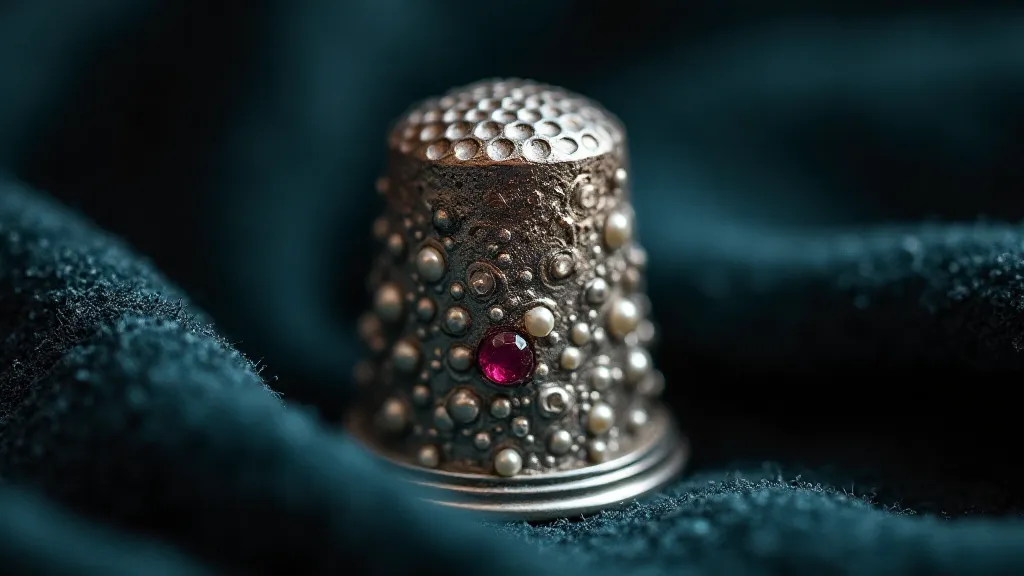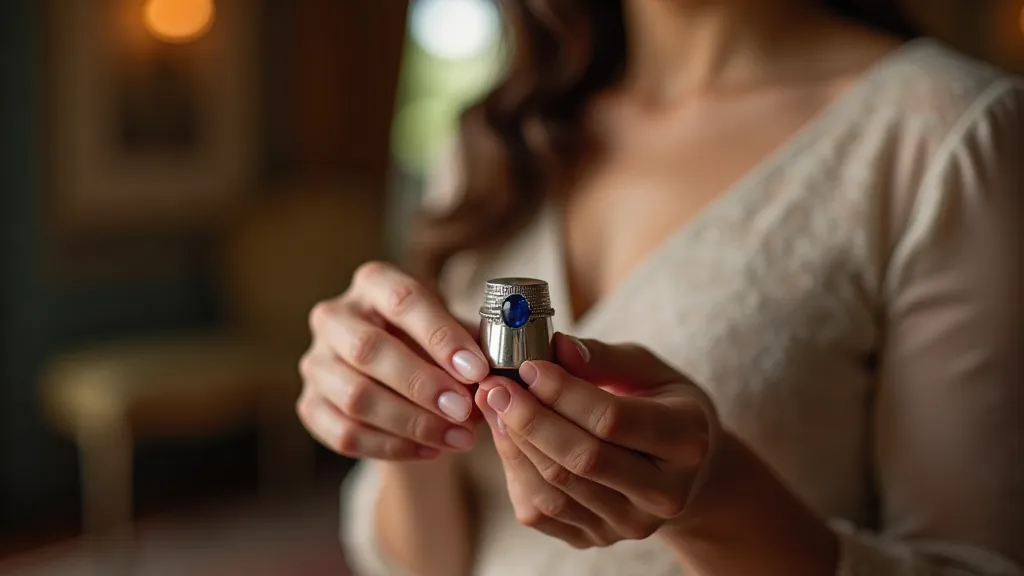The Jeweler’s Secret: How Precious Stones Elevate the Humble Thimble
The clinking of a needle, the rhythmic glide of fabric under expert hands - these are the sounds and sensations synonymous with sewing. And amidst this delicate ballet of creation, the humble thimble plays its quiet, essential role. We often overlook it, this tiny shield, but imagine a world where that unassuming object is transformed, elevated to an emblem of wealth and artistry – a miniature jewel box protecting the fingertip. This isn’t fantasy; it’s a glimpse into the surprising history of antique thimbles, and specifically, the rare and exquisite instances where precious stones were incorporated into their design.
For centuries, the thimble existed solely for practicality. From simple sheet metal to horn and bone, these protectors shielded fingers from repeated needle pricks. They were tools, essential to the craft, and as such, weren't considered objects of luxury. But as societies grew more complex, and as the desire to display wealth and status permeated every facet of life, even the most utilitarian items began to be adorned. And while the vast majority of antique thimbles remain modest in their materials, the few that feature precious stones offer a fascinating window into a world of opulence and bespoke craftsmanship.

The Rise of Ornamentation: A Reflection of Society
The 18th and 19th centuries witnessed a boom in ornamentation across various crafts. The Industrial Revolution, while bringing about mass production, also spurred a counter-movement of appreciating handcrafted artistry. Sewing, traditionally a domestic skill, became increasingly associated with femininity and refinement. As women of means sought ways to express their status and taste, even sewing accessories became opportunities for showcasing wealth. Silver thimbles became increasingly popular, providing a perfect canvas for intricate engraving and, occasionally, the setting of precious stones.
The choice of stones themselves was significant. Diamonds, of course, were the ultimate symbol of status, but their rarity and cost meant they were exceptionally uncommon in thimble design. Rubies, sapphires, and emeralds, while less expensive than diamonds, still represented significant investment and were indicative of considerable wealth. Even semi-precious stones like amethyst or garnet, when expertly cut and set, could lend an air of luxury to a thimble.
I recall visiting a small antique shop in Dorset, England, many years ago. Amongst a jumble of chipped porcelain and tarnished silverware, I spotted a thimble unlike any I’d ever seen. It was silver, intricately chased with floral motifs, and nestled within the chase was a single, oval amethyst. The owner, a kindly woman with twinkling eyes, told me that it likely belonged to a member of the landed gentry, perhaps a young woman learning to sew as part of her genteel upbringing. It was that moment I truly understood that these aren't just sewing tools; they’re tangible connections to history, whispering tales of lives lived long ago. The appreciation for these intricate creations extends beyond the thimble itself; consider the broader world of hand-sewn textiles and the sense of companionship they inspire, explored further in Ephemeral Echoes: The Vanishing Art of Hand-Sewn Textiles & Thimble Companionship.
Craftsmanship and the Jewelers’ Touch
The incorporation of precious stones into thimble design wasn't merely a matter of gluing a gem onto a silver cup. It required the skill of a master jeweler. The silver needed to be expertly worked, the stones precisely cut to fit the design, and the setting secured to withstand the rigors of use. The techniques employed were the same as those used for creating more elaborate pieces of jewelry – granulation, chasing, repoussé. It was a true collaboration between the silversmith and the jeweler, resulting in a miniature masterpiece.
Often, the stones weren’t set into elaborate mounts, but rather flush with the surface of the silver, creating a seamless and elegant design. This required exceptional precision and a deep understanding of both metalworking and gemology. The settings were typically closed, protecting the stones from damage and ensuring their longevity. The level of detail in the surrounding silverwork – the chasing, the engraving – often complemented the brilliance of the stone, drawing the eye and highlighting its beauty. Think of it as the jeweler’s secret – elevating a simple tool into a tiny, wearable treasure. The meticulous attention given to these miniature objects often reflects a wider pursuit of perfection, echoing the dedication of collectors who obsess over their acquisition and the stories they represent, as detailed in The Collector's Shadow: Obsession, Memory, and the Pursuit of Miniature Perfection.

Rarity and Value: Identifying a Gem-Set Thimble
Finding a thimble adorned with precious stones is an uncommon experience. While thousands upon thousands of antique thimbles exist, the number with gem settings is incredibly small. This rarity contributes significantly to their value, both sentimental and monetary. Determining authenticity and value requires a careful examination.
Firstly, the material of the thimble itself is crucial. Most gem-set thimbles are silver, often marked with hallmarks indicating the silver purity and maker's mark. Examine the hallmarks carefully – they can provide valuable information about the thimble's origin and age. Secondly, the stones themselves need to be assessed. Are they genuine? What is their quality? A reputable gemologist can provide an accurate appraisal. Thirdly, consider the overall craftsmanship. Does the setting appear well-made and secure? Does the design integrate the stones seamlessly into the overall aesthetic?
Remember, a poorly executed gem setting can detract from the value of the thimble, even if the stones themselves are genuine. Over time, wear and tear can also affect the value, particularly if stones have become loose or the setting is damaged. Restoration, if attempted, should be undertaken by a qualified professional specializing in antique silver and gemstones. The precision necessary for setting these stones and achieving such intricate details is a testament to a dedication to detail that extends to other crafts, mirroring the craftsmanship of clockmakers and their legacy of miniature precision, explored in greater detail elsewhere.
The Legacy of Precision: Beyond the Gemstone Setting
The remarkable level of craftsmanship found in gem-set thimbles isn’t solely attributable to the jeweler’s skill in handling precious stones. The entire process, from the shaping of the silver to the final polishing, demanded an exceptional degree of precision and artistry. This is particularly evident in the intricate chasing and engraving work that often surrounds the gemstones, showcasing the silversmith's mastery of their craft. The very act of creating a thimble, even without precious stones, speaks to a history of meticulous design and execution, emphasizing the importance of accurate measurement and consistent technique. The miniature nature of these objects necessitates an almost microscopic attention to detail, a quality that resonates across various disciplines.
Furthermore, the design choices themselves reveal a deep understanding of aesthetics and proportion. The placement of the gemstones, the balance of the overall design, and the integration of decorative elements all contribute to the thimble's visual appeal. It’s a miniature work of art, a testament to the ingenuity and skill of the artisans who created them. The pursuit of this precision also reflects the values of the society in which they were made—a society that placed a high premium on craftsmanship, artistry, and attention to detail. It stands as a reflection of an era where even the most utilitarian objects were imbued with a sense of beauty and purpose.
A Legacy of Skill and Status
The existence of gem-set antique thimbles serves as a fascinating reminder of a time when even the most mundane objects were imbued with artistry and status. They represent a unique intersection of craft, luxury, and personal expression. Each one tells a story—a whispered narrative of wealth, refinement, and the enduring beauty of handcrafted artistry. They are more than just sewing tools; they are miniature time capsules, offering a glimpse into a world of elegance and skill. And as we continue to appreciate the artistry of the past, these tiny jewels offer a captivating glimpse into the jeweler’s secret—a testament to the enduring power of transforming the ordinary into the extraordinary. The vibrant colors often incorporated into these designs aren't just decorative; they have a symbolic significance, contributing to the overall narrative and aesthetic appeal, a topic explored further in discussions about the language of color in antique decoration.






